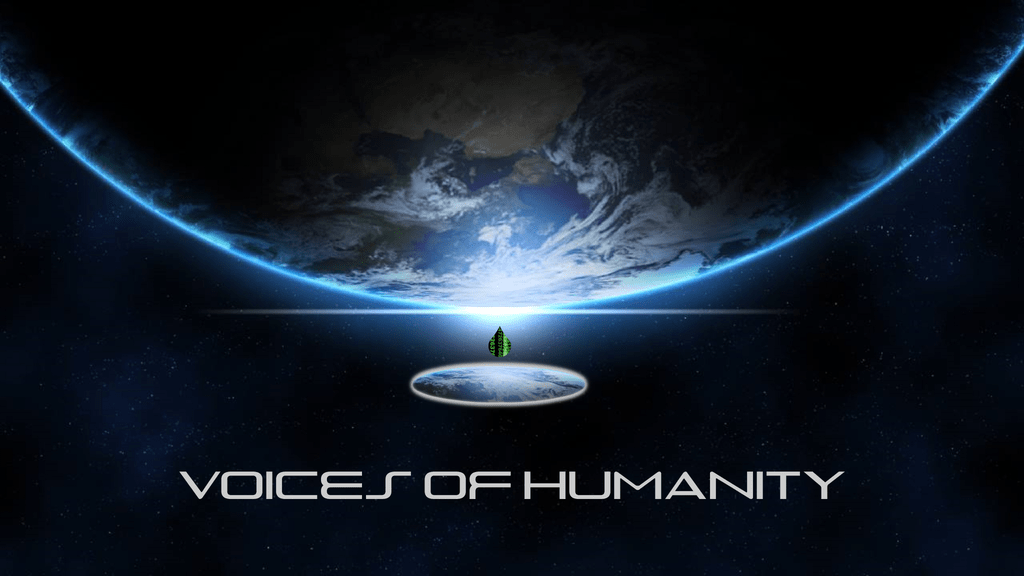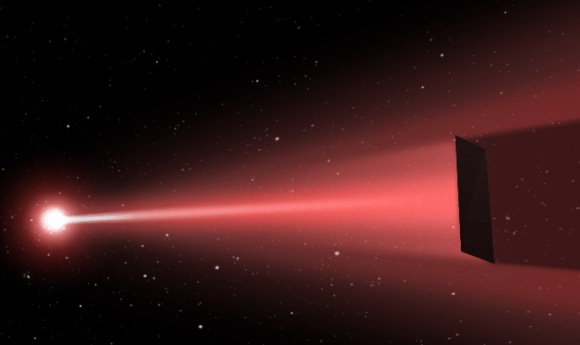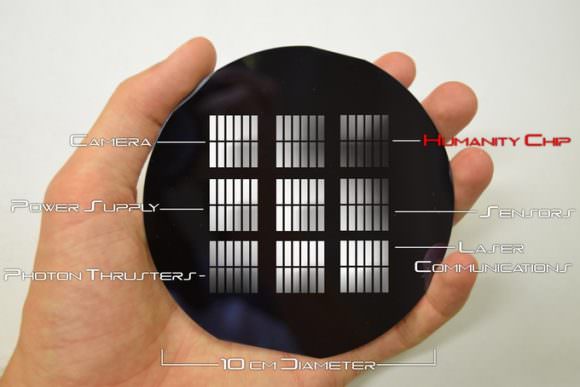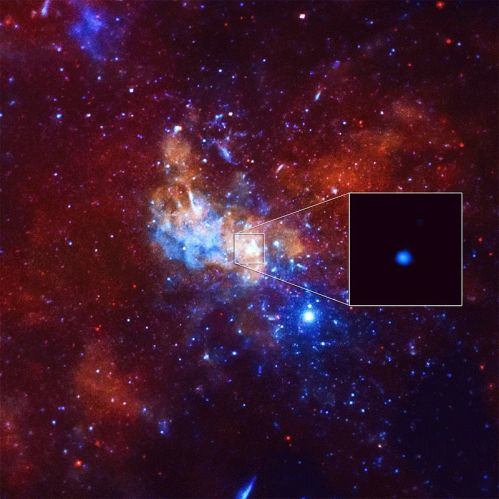Setting foot on a distant planet... we've all dreamed about it at one time or another. And it has been a staple of science fiction for almost a century. Engage the warp dive, spool up the FLT, open a wormhole, or jump into the cryochamber. Next stop, Alpha Centauri (or some other star)! But when it comes to turning science fiction into science fact, there are certain unfortunate realities we have to contend with. For starters, none of the technology for faster-than-light travel exists!
Second, sending crewed mission to even the nearest planets is a very expensive and time consuming endeavor. But thanks to ongoing developments in the fields of miniaturization, electronics and direct-energy, it might be possible to send tiny spacecraft to distant stars in a single lifetime, which could carry something of humanity along with them. Such is the hope of Professor Philip Lubin and Travis Bradshears, the founders of "
Voices of Humanity
".
For people familiar with directed-energy concepts, the name Philip Lubin should definitely ring a bell. A professor from the University of California, Santa Barbara (UCSB), he is also the mind behind the NASA-funded
Directed Energy Propulsion for Interstellar Exploraiton
(DEEP-IN) project, and the
Directed Energy Interstellar Study
. These projects seek to use laser arrays and large sails to achieve relativistic flight for the sake of making interstellar missions a reality.
Looking beyond propulsion and into the realm of public participation in space exploration, Prof. Lubin and Bradshears (an engineering and physics student from the University of California, Berkeley) came together to launch Voices of Humanity (VoH) in 2015. Inspired by their work with NASA, this Kickstarter campaign aims to create the world's first "Space Time Capsule".
Intrinsic to this is the creation of a Humanity Chip, a custom semiconductor memory device that can be attached to the small, wafer-scale spacecraft that are part of DEEP-IN and other directed-energy concepts. This chip will contain volumes of data, including tweets, media files, and even the digital DNA records of all those who want to take part in the mission. As Professor Lubin told Universe Today in a phone interview:
This digital archive would be similar to the
Golden Record
that was placed on the
Voyager
probes, but would be much more sophisticated. Taking advantage of all the advances made in computing, electronics and data storage in recent decades, it would contain many millions of times the data, but comprise a tiny fraction of the volume.
[caption id="attachment_128441" align="aligncenter" width="580"]
The DEEP-laser sail concept, showing a laser-driven sail. Credit and Copyright: © 2016 UCSB Experimental Cosmology Group.
[/caption]
In fact, as Lupin explained, the state of technology today allows us to create a digital archive that would be about the same size a fingernail, and which would require no more than a single gram of mass to be allocated on a silicon wafer-ship. And while such a device is not the same as sending astronauts on interstellar voyages to explore other planets, it does allow humanity to send something of itself.
"We now have the technology to put a message from everyone on Earth onto a small piece of a tiny spacecraft," said Lupin. "We want to begin today, and not just for the future, by putting information onto anything that is launched from Earth. We are the point technologically, at this moment, that we could put a small portion of humanity on this spacecraft."
In essence, human beings would be able to create the interstellar equivalent of a "Baby on Board" sticker, except for humanity instead. This sticker would be no larger than a postage stamp, and could be mounted on every craft to leave Earth in the near future. In essence, all missions departing from Earth could have "Humanity on Board".
The plan is to launch their first chip - Humanity Chip 1.0 - into Low Earth Orbit (LEO) in 2017. This will be followed by the creation of Humanity Chip 2.0, which take advantage of the developments that will have occurred by next year. Eventually, they hope that Humanity Chips will be a part of missions that increase in distance from Earth, eventually culminating in a mission to interstellar space.
[caption id="attachment_130305" align="aligncenter" width="580"]
Artist's rendition of The Humanity chip placed on a silicon wafer spacecraft. Credit: Voices of Humanity/kickstarter.com
[/caption]
While there are no deep-space missions ready to go just yet, several concepts are on the table for interplanetary missions that will rely on wafer-scale spacecraft (like NASA's DEEP-IN concept). If their Kickstarter campaign succeeds in raising the $30,000 necessary to create a Humanity Chip, Prof. Lubin and Bradshears also hope to create a "Black Hole Chip", where participants will be able to record their "less than happy" thoughts as part of the data, which will then be sent off into space forever.
They also have a stretch goal in mind, known as the "Beam Me Up" objective. In the event that their campaign is able to raise $100,000, they will use the funds to create a ground-based laser array that will beam a package of encoded data towards a target destination in space.
As of the penning of this article, Prof. Lubin and Bradshears have raised a total of $5,656 towards their goal of $30,000. The campaign kicked off earlier this month and will remain open for another 22 days. So if you're interested in contributing to Humanity Chip 1.0, or becoming an "Emissary of the Earth", there's still plenty of time.
In addition to his work with NASA, Prof. Lubin is also responsible for the UCSB's
D irected E nergy S ystem for T argeting of A steroids and Explo R ation
(DE-STAR) project, a proposed system that would use directed energy (i.e. big lasers!) to
deflect asteroids
, comets, and other near-Earth objects (NEOs) that could pose a risk to planet Earth.
[caption id="attachment_130316" align="aligncenter" width="499"]
The Black Hole Chip is one of the stretch goals, which will send "less than happy" thoughts into space. Credit: Voices of Humanity/kickstarter.com
[/caption]
And, in a recent article titled "
The Search for Directed Intelligence
"- which appeared in the March 2016 issue of
*REACH – Reviews in Human Space Exploration*
- Lupin indicated that advances in directed-energy applications might also help in the search for extra-terrestrial intelligence. Essentially, by looking for for sources of directed energy systems, he claims, we might be able to find our way to other civilizations.
It is an exciting age, where advances in telecommunications and electronics are allowing us to overcome the vast distances involved in space travel. In the future, astronauts may rely on robotic explorers and
fast-as-light
communications to explore distant worlds (a process known as
telexploration
). And with a digital archive on board, we will be able to send personal greetings to any life that may already exist there.
For those who would say "sharing personal information with extra-terrestrials is a bad idea", I would remind them that they (probably) don't have access to Twitter or our financial records. All the same, it might be wise not to include your Social Security (or Social Insurance) number in the recordings, or any other personal data you wouldn't share with strangers!
And who knows? Someday, we may start colonizing other planets by sending our DNA there direct. The truth is always stranger than fiction, after all!
And be sure to check out this video produced by Voices for Humanity:
https://ksr-video.imgix.net/projects/2269573/video-685249-h264_high.mp4
Further Reading: Voices of Humanity
 Universe Today
Universe Today



